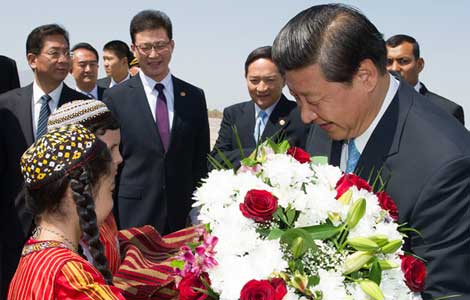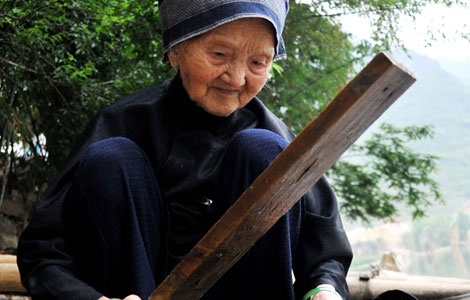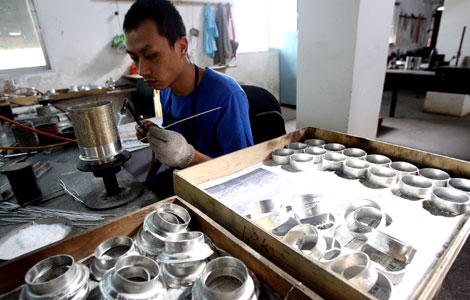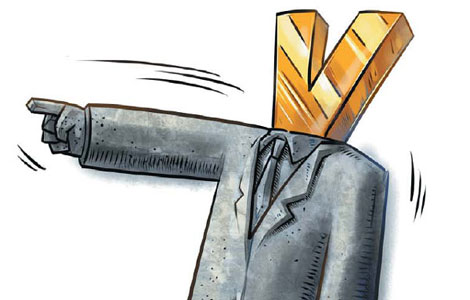Urbanization drive should balance speed, quality
Updated: 2013-09-04 07:44
By Zheng Yangpeng (China Daily)
|
||||||||
China's leadership is relying on urbanization to counter slowing economic growth and support structural reform. But how fast should the process go?
A report by the United Nations Development Program and the Institute of Urban and Environmental Studies under the Chinese Academy of Social Sciences has offered an answer.
The report urged China's leaders to strike a balance between speed and quality in the process of urbanization. The success of the process, the report said, should not only be measured by GDP and urban resident numbers, but also by the livability of cities.
"The most realistic pathway to optimal urbanization may entail a compromise between the quality and scale of urbanization. Such an approach could likely lead to slower aggregate GDP growth than the rapid urbanization scenario, but it will also bring higher human development benefits," Helen Clark, administrator of the UNDP, said at a ceremony to mark the release of the report.
China's urbanization has been breathtaking. It took just 60 years for the country's urbanization rate to leap from 10 percent to 50 percent. The same achievement took 150 years in Europe and 210 years in Latin America.
In the past decade, the process became so frenetic that one foreign newspaper remarked: "Perhaps Rome was not built in a day. But at China's current rate of construction, it would roughly take two weeks."
But urbanization has posed mounting challenges for China's resources, environmental conditions, job market and public services. As more Chinese enjoyed the prosperity of modern cities, they've also had to contend with traffic congestion, skyrocketing home prices and choking air.
By 2030, the nation's urban population is forecast to grow by an additional 310 million people, the equivalent of the entire population of the United States, to 70 percent of the total population. By this point, more than 1 billion Chinese will live in cities. The new urbanites will require more space, water and food, imposing severe environmental pressures.
The report warned that China's leaders have just a short window of opportunity to make policy decisions. Inertia will mean worsening living conditions - more importantly, it will challenge the sustainability of social and economic development.
"China's fast-aging population, as well as the 262-million migrant population, mean there's no time to lose," said Pan Jiahua, director of the Institute of Urban and Environmental Studies and a chief editor of the report.
The report drew up three different scenarios for urbanization.
In the speed scenario, China's urban population will reach 71 percent of its total population by 2030, and GDP generated by cities could amount to 110 trillion yuan ($17.9 trillion). But this speed also comes at the expense of per capita living space and water consumption, as well the supply of subsidized housing.
In the "moderate pace" and "moving more slowly" scenarios, fewer people would live in cities by 2030 and cities' total GDP would be smaller. But people will have larger and more affordable homes and enjoy more drinkable water.
The latter two scenarios would cost more. For example, in the speed scenario, it takes about 80,000 yuan to transform a migrant worker into full urban resident. In the "moving more slowly" scenario however, it would take about 150,000 yuan.
Given the current institutional environment, will local officials be willing to spend more to turn migrant workers into full citizens, instead of relentlessly pursuing GDP growth?
The report suggested reform of the incentives and performance evaluations of public officials. There should be a more open and transparent decision-making process and more public involvement, it said. Also, local governments need more financing options to reduce their dependence on land transaction revenues.
zhengyangpeng@chinadaily.com.cn
(China Daily USA 09/04/2013 page15)

 US missile destroyers stand by in Mediterranean
US missile destroyers stand by in Mediterranean
 Obama wins key backing on Syria strike
Obama wins key backing on Syria strike
 The first Chinese to reach US Open semi-final
The first Chinese to reach US Open semi-final
 Photos: Daily life for Free Syrian Army
Photos: Daily life for Free Syrian Army
 Fewer Chinese students apply to US graduate schools
Fewer Chinese students apply to US graduate schools
 Technology transfer is a focus
Technology transfer is a focus
 Syrian refugees exceed 2m
Syrian refugees exceed 2m
 Energy partners boost gas supplies
Energy partners boost gas supplies
Most Viewed
Editor's Picks

|

|

|

|

|

|
Today's Top News
Kodak emerges from bankruptcy
Senate agrees on draft authorization on Syria
Local debts not to drag China into financial crisis
Police name attacker who took boy's eyes
Fewer Chinese apply to US graduate schools
Japan urged to face history
Energy partners boost gas supplies
Trending news across China
US Weekly

|

|





